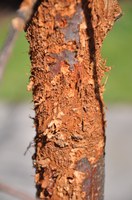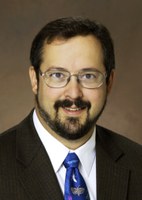Dakota Gardener: The Birds and the Trees
(Click an image below to view a high-resolution image that can be downloaded)
By Joe Zeleznik, Forester
NDSU Extension
I love feeding the birds in the winter.
We set out several different types of feeders in the backyard and get a variety of birds: blue jays, black-capped chickadees, nuthatches, four different kinds of woodpeckers.
It’s a pleasure watching their dance. The woodpeckers go for suet and the blue jays prefer peanuts, when we can keep that feeder filled. The other birds compete for the smaller seeds and other food: sunflower seeds, millet, cracked corn. And the squirrels compete for all these foods.
So that overall dance is complicated. Some species aren’t competing with each other while others vie for the same food resources. Competition is tough enough, much less avoiding becoming prey for some other critter.
While the birds feast at our feeders, they also forage for food on our trees or elsewhere in the neighborhood. The nuthatches hunt for insects in bark crevices or under plates of bark on the stems. They don’t dig into the stems like the woodpeckers do, but instead they cling to the stem with their heads pointed down (which is weird, but cool), searching in bark cracks for a little snack.
The woodpeckers are beautiful, but they worry me. When they forage for insects, they dig into the stem, which can cause a lot of damage. About 15 years ago, my colleagues and I noticed that many young bur oak trees were showing dieback of their branches in the spring. Those branches showed a “shredded” appearance on their bark. We needed a few years to figure out the problem.
Apparently, the downy woodpeckers and possibly the hairy woodpeckers were digging for the larvae of a stingless wasp. The damage caused by the birds is amazing, but I can’t blame them. They’re going for the wasps. If we can control the wasps, then the birds won’t dig for them. We just haven’t quite figured out yet how to control the wasps. It’s a challenging ecology.
The pileated woodpeckers are amazing. We call them “pterodactyls” because they’re so big and look menacing. They’ve knocked off some pretty big chunks of bark from our maple and oak trees. I’m worried about those trees as well.
Early last year, an ash tree fell over in my neighbor Bill’s woodlot during a storm. The tree had been declining for several years and had a number of large holes in the stem, probably from pileated woodpeckers. The tree also had a large rotten area at the bottom, weakening its structure. I was able to find a solid section about 10 feet up the stem and cut a cross-section. The tree was more than 200 years old!
In the summer, I struggle with another type of woodpecker called a yellow-bellied sapsucker. These birds drill small holes - called “wells” - in a straight line in tree bark. The sweet sap collects in these wells and the birds collect the sap and sometimes insects with their specialized tongue. Constructing and maintaining the wells can cause considerable damage to the tree. I’m still trying to get my apple tree back into shape after the sapsuckers nearly girdled it.
One online source states that sapsuckers feed on more than 150 different tree species, including deciduous trees and conifers. Another source says more than 1,000 different tree species host sapsuckers.
Regardless of the exact number, sapsuckers clearly can be a big problem. I most often see their damage on birches, mountain-ash trees, elms, maples and apples. I’ve also seen them kill spruce and pine trees on occasion.
It’s quite a dilemma. Do I discourage the birds and try to eliminate or minimize damage to the trees? Or do I keep encouraging the birds to come into the yard and use it for habitat?
So far, the birds are winning.
For more information about gardening, contact your local NDSU Extension agent. Find the Extension office for your county at https://www.ag.ndsu.edu/extension/directory/counties.
NDSU Agriculture Communication - Jan. 12, 2021
Source: Joe Zeleznik, 701-231-8143, joseph.zeleznik@ndsu.edu
Editor: Ellen Crawford, 701-231-5391, ellen.crawford@ndsu.edu




